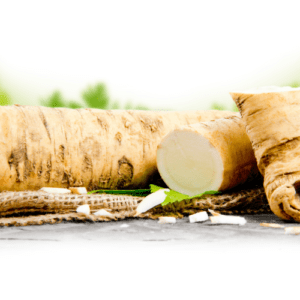Chinese artichoke, Stachys affinis, is a perennial herbaceous plant in the Lamiaceae family, which also includes familiar plants like mint and sage. Native to Northern China and cultivated in East Asia, this plant is particularly notable for its edible tubers, which are appreciated for their unique appearance and culinary uses.
The tubers are small, elongated, and knobby, resembling ginger root. They usually grow to about 2-3 inches in length. The plant itself has leaves that are somewhat similar to mint leaves.
They have a crisp texture and a sweet, nutty flavour, often compared to Jerusalem artichokes or water chestnuts and are enjoyed both raw and cooked.
Like many root vegetables, Chinese artichokes are a good source of carbohydrates and dietary fiber. They also contain various vitamins and minerals, although specific nutritional information can vary.
This plant is relatively easy to grow and is often cultivated in home gardens. It prefers well-drained soil and can tolerate partial shade. The tubers are typically harvested in late autumn or early winter.
How to eat Chinese artichokes? These tubers have a crisp texture and nutty flavour, can be used in a variety of recipes. They are quite versatile and can be a unique addition to many dishes. Here are some recipe ideas:
1. Salads: Slice them raw and add to salads for a crunchy texture. They pair well with leafy greens, vinaigrettes, and other salad vegetables.
2. Stir-Fries: Dice or slice them and add to stir-fries. They can be combined with a variety of vegetables, meats, and sauces, absorbing flavours while retaining their crunch.
3. Pickles: You can pickle Chinese artichokes in a vinegar-based brine, perhaps with spices and herbs, to create a tangy, crunchy condiment.
4. Roasted or Baked: They can be roasted or baked, either whole or sliced, with a drizzle of olive oil and a sprinkle of herbs and spices, until tender.
5. Soups and Stews: Add them to soups and stews where they can contribute a unique texture and flavour, similar to the way potatoes or Jerusalem artichokes are used.
6. Steamed or Boiled: Simply steamed or boiled, they can be a delightful side dish, perhaps tossed with a bit of butter or olive oil and herbs.
Chinese artichokes are usually ready to be harvested in late autumn or early winter. The exact timing can depend on the climate and growing conditions. They are harvested after the plant’s foliage has started to die back. The tubers can be left in the ground and harvested as needed, as they store well in the soil, especially in colder climates. However, if you’re in an area with very cold winters, it’s best to harvest them before the ground freezes. After harvesting, they can be stored in a cool, dry place for several weeks.
Can these tubers be left in the ground over winter?
Yes, Chinese artichokes can typically remain in the ground over the winter and still be good for eating in the spring. This characteristic is one of the convenient aspects of growing them. Here are some considerations for overwintering Chinese artichokes:
Winter Hardiness: Chinese artichokes are quite hardy and can survive in the ground through the winter in many climates. The soil acts as a natural insulator against cold temperatures.
Soil Protection: In areas with very harsh winters, it’s advisable to mulch the soil where they are planted. This provides extra insulation and helps prevent the ground from freezing too deeply, which could make spring harvesting difficult.
Quality and Flavour: The tubers can maintain their quality and flavor while overwintered in the ground. Some gardeners even believe that the flavour improves after a frost, as with some other root vegetables.
Spring Harvest: As the weather warms up in the spring, you can begin harvesting them as needed. They typically resume growth in the spring, so it’s a good idea to harvest before new growth starts to ensure the best quality.
Pest Considerations: While Chinese artichokes are relatively pest-resistant, leaving them in the ground could potentially expose them to soil-borne pests and rodents. Regular checks and good garden hygiene can help mitigate these risks.
These tubers are available directly from Garden Faerie Botanicals in the heart of British Columbia, Canada. The collection features heirloom and heritage seeds that are personally cultivated organically without the use of any chemicals. Emphasizing historical, rare, non-GMO seeds, this selection preserves biodiversity through open-pollination.








Reviews
There are no reviews yet.